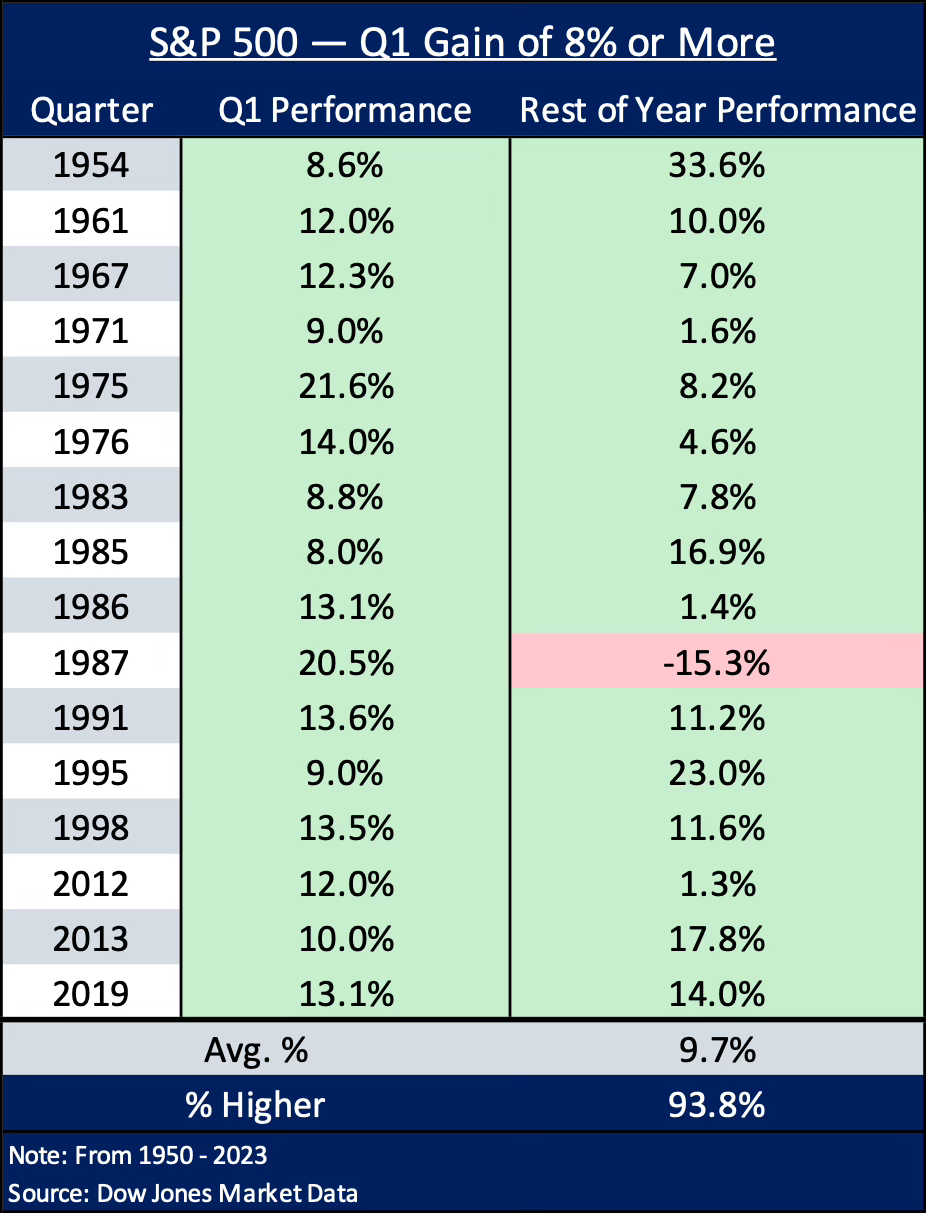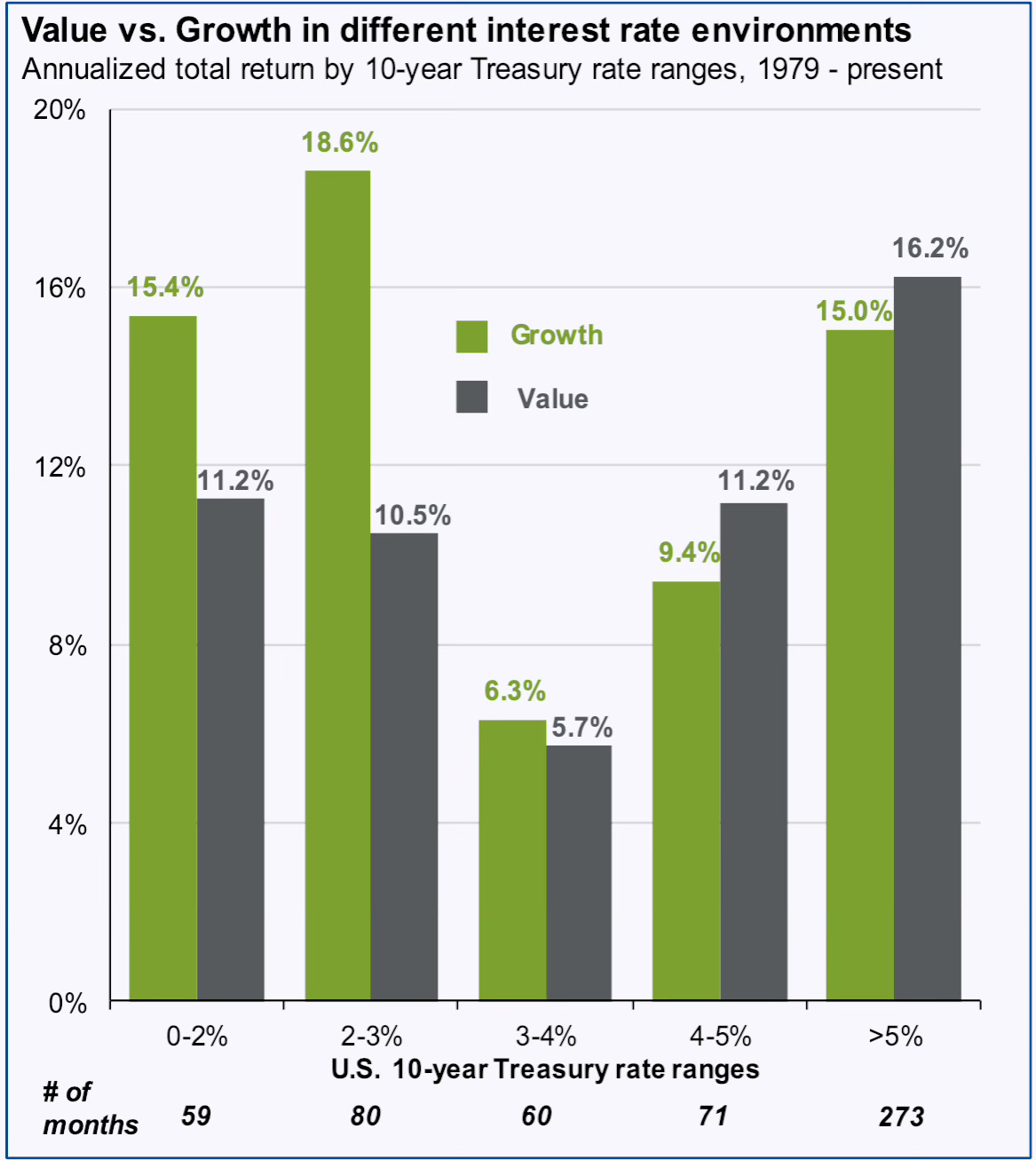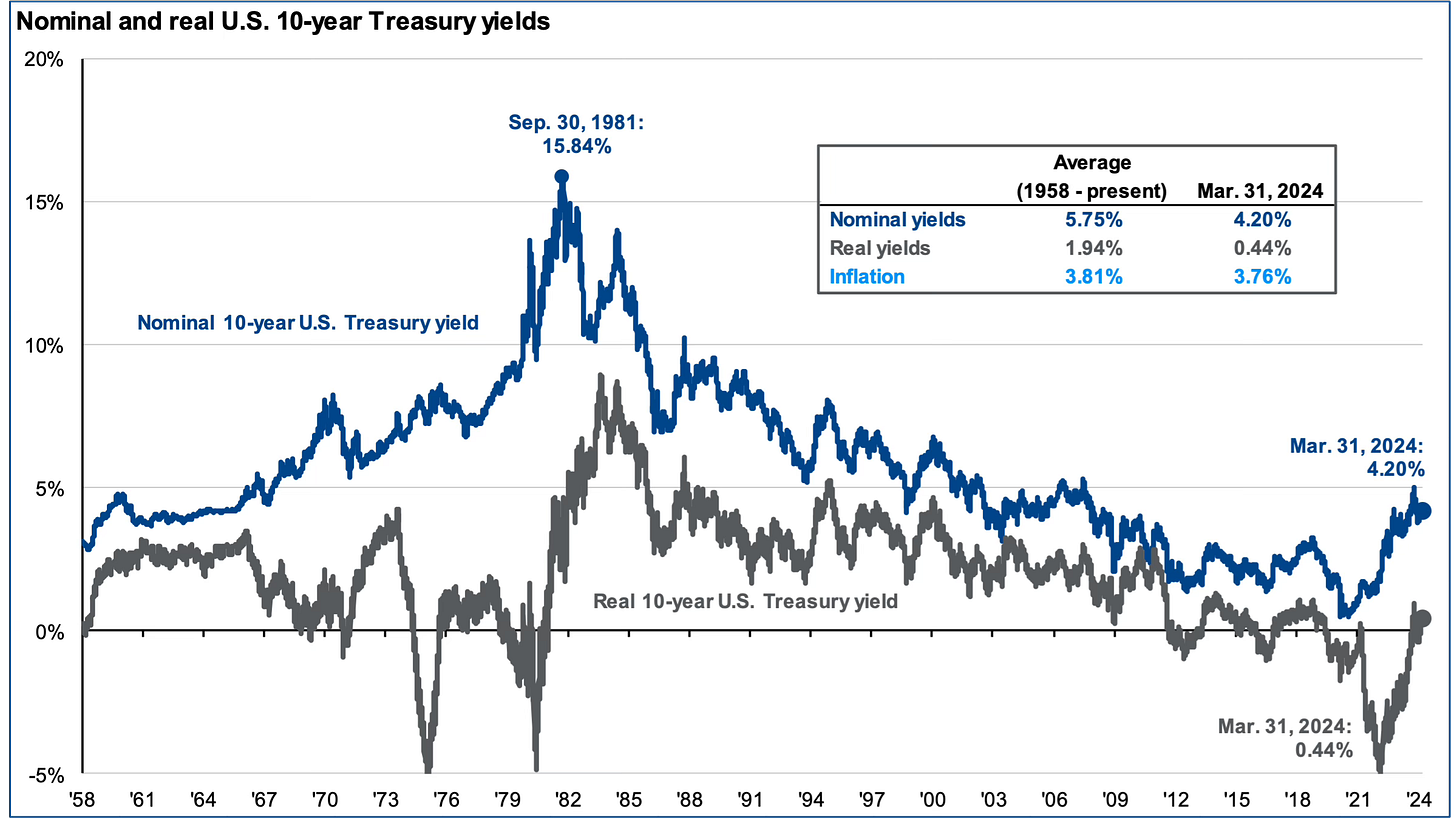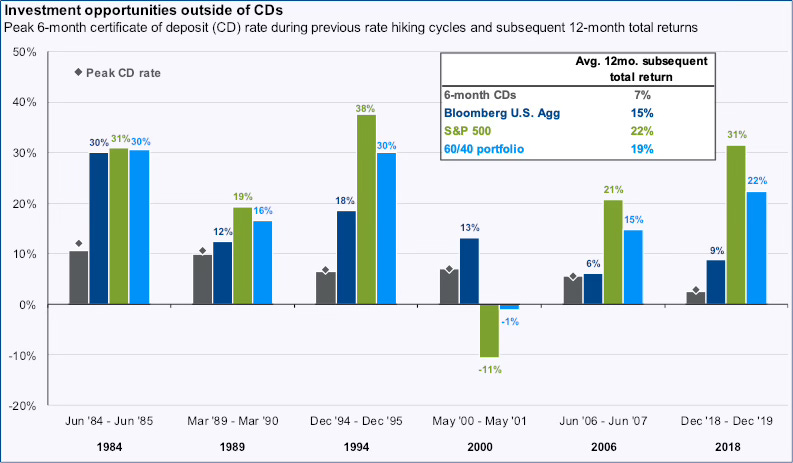Interesting Fact:
According to Bloomberg, more than one-fifth of the nearly 500 SPAC deals that have closed since 2019 are trading below $1 each, representing a greater than 90% plunge.
On Friday, we released our quarterly letter to our research subscribers. In this week’s Digest, we present it to you.
Boyar Value Group’s Quarterly Letter: 1Q 2024
While it might seem that anyone can be a value investor, the essential characteristics of this type of investor—patience, discipline, and risk aversion—may well be genetically determined.
–Seth Klarman
The Momentum Continues
The S&P 500 increased by 10.2% during 1Q 2024, closing at a record high 22 times during the quarter—the highest figure since 1Q 1998 and a stark contrast to 2023, when it had no record closes throughout the year (the first time since 2012) despite advancing by 24%. (Note: The figures in this section are not inclusive of dividends.) From 1950 through 2023, the S&P 500 has gained 8% or more 16 times in 1Q. In 15 of those instances, it added to its gains throughout the year, for an average advance of 9.7% over the following 3 quarters according to Teresa Rivas writing for Barron’s. (In 1987, the one exception, the S&P 500 started the year with a blistering 20% advance for 1Q, but on October 19, Black Monday, it declined by over 20% in a single day—yet, remarkably, still finished positive for the year.)
Although a strong start to the year is generally a bullish signal, investors should curb their enthusiasm for spectacular gains for the rest of 2024: in 10 of those 15 years, the 1Q gains eclipsed those of the remaining 3 quarters combined.
AI Mania and Signs of Froth
Investors continued their love affair with all things AI, sending Nvidia up 80% during 1Q 2024 (adding more than $1 trillion in market value to a market capitalization that now eclipses both Amazon’s and Alphabet’s)—and this after 2023’s standout performance, when shares more than tripled in value. Nvidia is now the biggest holding in individual investors’ portfolios, at ~9% (surpassing Tesla, previously the most popular stock), according to data from VandaTrack. Other stocks that investors believe will benefit from AI are drawing similar attention: Super Micro Computer Inc, and MicroStrategy, for example, advanced by 255% and 170%, respectively.
Signs of speculation in the financial markets abound (and make us somewhat nervous), with Bitcoin having advanced ~61% for the quarter after various Bitcoin ETFs were made available to the public. Similarly, the Donald Trump-controlled Truth Social sported a market cap of ~$8 billion at the end of the quarter (despite having posted tens of millions of dollars in losses since 2021 and having generated a paltry ~$4 million—not a typo—in sales in 2023) before falling ~44% thus far in April. Similarly, social media company Reddit, which has never posted a full-year profit since its founding in 2005, advanced 48% on its first day of trading as a public company and is valued at ~$7 billion.
Interest Rates
These spectacular gains occurred even after two hotter-than-expected inflation reports (and continued economic momentum) reduced investor expectations to just two or three rate cuts in 2024 (down from ~6 interest rate cuts that were expected before the year began)—a stark contrast to the equity rally of Q4 2023, which was fueled in part by expectations that the Federal Reserve would soon pivot and begin to decrease rates. Although it is worth noting that a stronger than anticipated inflation report released on April 10th sent the major indices down sharply (due in part to worries that Fed rate cuts may be delayed longer than anticipated).
In response to elevated—and not-so-transient—inflation, the Federal Reserve started hiking rates aggressively in March 2022, with 11 hikes ranging from 25 bps to 75 bps each, bringing the Fed funds rate from near zero to 5.25%-5.5% in less than 1½ years—the fastest rate hiking cycle since the 1980s. During this time, the 10-year yield surged from under 2.5% to, briefly, more than 5.0% last October. Since then, however, it has undergone a sudden retracement as the Fed has paused hiking interest rates, with interest rate cuts now expected sometime in 2024 (although the talking heads on Wall Street hotly debate both their amount and their timing). While CPI inflation has cooled from a peak of 9.1% in June 2022, it has remained stuck in a 3.0%-4.0% range over the last 12 months (with hotter-than-expected rates throughout Q1 2024), stubbornly higher than the Fed’s 2.0% target.
Impact on Stock Market Investing
What does the current interest rate environment mean for equity investors? According to JP Morgan, since 1979 there have been 71 months when 10-year Treasuries were 4%-5% (currently ~4.5%). During those times, value stocks’ annualized total return was 11.2%, versus 9.4% for growth shares. During the 60 months when the U.S. 10-year was in the 3%-4% range, value stocks’ annualized total return was 5.7%, versus 6.3% for growth stocks.
Mild-to-moderate levels of inflation are normal and, in fact, can be a symptom of economic prosperity. Inflation can even be beneficial to companies in commodity-related industries (i.e. food, energy, miners, steelmakers, chemical producers), which are more commonly associated with value than growth, and who are likely able to assert pricing power. Despite an uneven effect across economic sectors, the impact on broader stock market valuations is clear: elevated levels of inflation (exacerbated by accompanying rising interest rates during such periods) generally correlate with lower P/E multiples.
Interest rates’ effect on value versus growth stocks makes sense: investors’ willingness to pay higher valuations for growth stocks partly depends on the present value of future cash flows, which are more significantly discounted against higher-interest-rate backdrops. Furthermore, financial companies (such as banks and insurers), which make up a meaningful percentage of the “value” indices, have historically performed better in times of higher inflation, which are usually also times of higher interest rates.
We don’t know when the Fed will start cutting interest rates, but we don’t expect a return of the ultra-low rates we saw after the Great Financial Crisis and during the COVID-19 pandemic. Most Fed officials believe that short-term rates will likely close out 2024 in the 4.5%-5.0% range, and only one of them sees the Fed funds rate going below 2.5% over the longer run. Meanwhile, the normalization of 10-year yields above 3% (currently ~4.5% as of April 11th), in combination with elevated growth stock valuations, seems to suggest that—unlike the long period when growth outperformed value between the Great Financial Crisis and the COVID-19 pandemic, while rates were historically low—value shares may be primed for a durable resurgence.
Whether the Fed reduces interest rates three times this year or only once (or not at all, as some are starting to suggest), investors should view current interest rates in their proper historical perspective. At 4.2% and 0.44% (as of March 31st2024), respectively, nominal and real yields are still low, historically speaking. The economy can function—and has repeatedly functioned—with rates at these (and even higher) levels. If they seem high, they are only high relative to recent history.
Reasons for Caution
As contrarians, we are given pause by the results of the latest Bank of America fund manager survey, with two-thirds of respondents not expecting a recession during the next 12 months. At the start of 2023, right before the S&P 500 began a 39% bull run (through 1Q 2024), that figure was a little over 10%. What’s more, that same survey, for the first time in over 2 years, showed that the majority of investors expect corporate profits to increase over the medium term according to The Financial Times, despite the currently elevated corporate profit margins by historical standards.
1Q 2024 brought a smooth advance with no meaningful pullbacks, but investors should remember that markets generally do not advance in a straight line. According to JP Morgan, since 1980 the S&P 500 has seen an average intra-year drop of 14.2%. With the biggest decline this year a trifling 2%, it would not be unusual for the market to suffer a fairly significant pullback at some point during the year—and in fact it would be perfectly normal.
The U.S. economy is in much better shape than most would have expected after such a rapid jump in interest rates, but we’re keeping a lookout for any early signs of trouble. The household debt service ratio (the percentage of after-tax income used to make payments on mortgages and other consumer debt) is starting to creep up, and early delinquencies on auto and credit card loans are also increasing despite very favorable levels of employment. The numbers we’re seeing so far aren’t anything to be overly concerned about, but we’re watching these indicators closely even so.
The State of the Market
The S&P 500 is in the midst of a 5-month winning streak, having ended 1Q 2024 selling for 21.0x (fwd.) earnings—an elevated valuation by historical standards. (The 30-year average is 16.6x.) The S&P 500 index level (5,254 as of March 31, 2024) has advanced ~10% since January 3, 2022 (the previous market peak), when it stood at 4,797, but it currently trades at a similar multiple of earnings. While 21.0x is an elevated multiple relative to history, back in March 2000 the S&P 500 traded for 25.2x (before losing 49% of its value over the following 2 calendar years). It is worth noting that the S&P 500 equal-weighted index currently sells for a more modest (but far from cheap) 17.2x (fwd.).
Market Concentration and Sector Returns
According to St. James Investment Company citing data from investment firm GMO, historically (dating back to 1957) the ten largest stocks in the S&P 500 have underperformed an equal-weighted index of the remaining constituents by 2.4% per year. However, the last decade has significantly deviated from this trend with the largest ten stocks outperforming by 4.9% per year on average, pushing the top ten stocks to an elevated percentage of the index relative to historical norms.
As of March 31, 2024, the 10 largest stocks in the S&P 500, as measured by market capitalization, were selling for 28.4x earnings (fwd.), compared to an average of 20.3x since 1996. What’s more, they currently sell at a multiple 35% higher than the overall market (and 40% more than the top 10 market capitalization names have historically sold for), and their weightings (at 33.5% of the S&P 500) are at multidecade highs. The stocks outside the top 10 aren’t cheap, either, at 18.3x earnings (fwd.) against an average of 15.7x since 1996, but they currently sell at a 13% discount to the overall market.
It is not just the S&P 500 that is heavily concentrated. According to The Financial Times the 10 largest stocks in the MSCI World Index account for 21.7% of its total market capitalization (a multi-decade high) and US stocks comprise 71% of the index.
The market rally has started to broaden, however, giving some hope of a sustained advance. During the quarter, over half the stocks in the S&P 500 have notched 52-week highs, according to data from the Wall Street Journal. Even so, the Magnificent Seven still dramatically affected the overall index results (though admittedly not as much as in 2023). According to Howard Silverblatt, senior analyst at S&P Global Indices, these seven stocks were responsible for 37% of the S&P 500’s 10.2% 1Q gain, compared with ~66% of the market’s gain in 2023. We do note, however, that performance within the Magnificent Seven has started to diverge materially, with Nvidia, Meta and Microsoft advancing 82.5%, 37.3%, and 12.1% during the quarter, respectively, with Apple and Tesla declining by 10.8% and 29.3%. (In fact, Silverblatt notes that Amazon, Meta, Microsoft, and Nvidia alone contributed 47% of the gains for the entire index).
Notably, 10 of the 11 S&P 500 sectors were positive for the quarter (with the sole decliner, real estate, losing 1.1%). Communication services was the best performer for 1Q 2023 (up 15.8%), followed by energy, which declined in 2023 but advanced by 13.7% to start the year; the third-best performer was technology, which advanced by 12.7%.
1Q 2023 Sector Returns
How Can I Invest in a Market Selling at All-time Highs?
As value investors with a contrarian streak, we like to invest when no one else wants to buy, so investing while the market is at all-time highs naturally feels uncomfortable to us. Historically, however, not investing simply because the market is at (or near) an all-time high has been a mistake. Trying to time the market is extremely difficult and the pitfalls trying to do so have been well documented. Interestingly, since 1950 the S&P 500 has closed at an all-time high 6.6% of the time (making today’s situation less rare than it might seem). In addition, as the following chart shows, historically there has not been a significant difference (in terms of future returns) between investing on a random day versus investing on days when the S&P 500 was at an all-time high. Most important, however, we invest in stocks—not markets. And although the major indices are arguably overextended at present, we still see stocks that we believe are intrinsically undervalued.
Did I Miss the Rally in Stocks?
After a large 2023 rally in U.S. equities, followed by a strong 1Q, many investors (professional and individual alike) might feel as if they have missed their chance for outsized gains and turn to money market funds, where they can currently obtain yields of almost 5% while taking minimal risk—a significant improvement from the near 0% rates savers have resigned themselves to in recent years.
However, investors should keep in mind that over a 2-year period, the S&P 500 has advanced 20% (a solid return no doubt but nothing out of the ordinary by historical measures)—and for those looking to invest in smaller companies, the Russell 2000 is 15% below its 2021 record. In addition, if history is any guide and rates have in fact peaked, we could be in for near-term equity outperformance. Since 1984 there have been six rate hiking cycles, and according to data from JP Morgan, cash tends to underperform both stocks and bonds the year after rates peak (five of the last six times). Either way, trying to time the market is usually detrimental to long-term returns.
The Wisdom of Taking a Long-Term View
We’ve said it before, and we’ll say it again: individual investors stack the odds of investment success in their favor when they stay the course and take a long-term view. According to data from JP Morgan, there has never been a 20-year period when investors did not average a gain of at least 6% per year in the stock market.
Past performance is certainly no guarantee of future returns, but history does show that the longer a time frame you give yourself, the better your chances become of earning a satisfactory return.
As always, we’re available to answer any questions you might have. In addition, you can reach us at Info@boyarvaluegroup.com or (212) 995-8300.
Best Regards,
Mark A. Boyar
Jonathan I. Boyar
Important Disclosures. The information herein is provided by Boyar’s Intrinsic Value Research LLC (“Boyar Research”) and: (a) is for general, informational purposes only; (b) is not tailored to the specific investment needs of any specific person or entity; and (c) should not be construed as investment advice. Boyar Research does not offer investment advisory services and is not an investment adviser registered with the U.S. Securities and Exchange Commission (“SEC”) or any other regulatory body. Any opinions expressed herein represent current opinions of Boyar Research only, and no representation is made with respect to the accuracy, completeness or timeliness of the information herein. Boyar Research assumes no obligation to update or revise such information. In addition, certain information herein has been provided by and/or is based on third party sources, and, although Boyar Research believes this information to be reliable, Boyar Research has not independently verified such information and is not responsible for third-party errors. You should not assume that any investment discussed herein will be profitable or that any investment decisions in the future will be profitable. Investing in securities involves risk, including the possible loss of principal.
Important Information: Performance Information. Past performance does not guarantee future results. The reports in this sample are for informational purposes only and the performance of the stocks selected is not indicative of the performance of all the stocks profiled in Boyar Research. The performance of the stocks selected and the performance of the stocks in Boyar Research may in fact diverge materially. Additional information regarding the performance of other companies featured in Boyar Research is available from Boyar Research upon request. This information is not a recommendation, or an offer to sell, or a solicitation of any offer to buy, an interest in any security, including an interest in any investment vehicle managed or advised by affiliates of Boyar Research. Any information that may be considered advice concerning a federal tax issue is not intended to be used, and cannot be used, for the purposes of (i) avoiding penalties imposed under the United States Internal Revenue Code or (ii) promoting, marketing or recommending to another party any transaction or matter discussed herein. Clients of an affiliate of Boyar Research and employees of Boyar Research own shares in Nvidia, Alphabet, Bank of America, and Microsoft.














